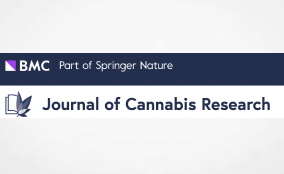Well spotted by Lex Pelger
You can read all his other amazing discoveries here. https://www.cannabinoidsandthepeople.whitewhalecreations.com/
AUTHORS
Journal of Cannabis Research volume 6, Article number: 37 (2024)
Abstract
Background
Driving after cannabis use (DACU) is associated with increased risk of motor vehicle collisions. As cannabis legalization expands, DACU is emerging as a major public safety concern. Attitudes have a significant impact on behavioural decision making. As such, understanding the degree to which people have favorable or unfavorable evaluations of DACU is an important first step for informing prevention efforts. This systematic review summarizes existing evidence on attitudes toward DACU, their association with actual or intended DACU, and changes in attitudes following legalization of recreational cannabis.
Methods
Four electronic databases (MEDLINE, EMBASE, PsycINFO, and TRID) were searched for studies that reported attitudes or changes in attitudes toward DACU published between their inception dates and February 26 2024. A total of 1,099 records were retrieved. Studies were analyzed using an inductive thematic synthesis approach.
Results
Seventy studies from seven countries originating predominantly from the United States and Canada met inclusion criteria. Thematic analysis identified six themes. (I) Attitudes toward the safety and acceptability of DACU are mixed; participants in 35 studies predominantly expressed negative attitudes toward DACU (e.g., DACU is dangerous, affects driving ability, and increases crash risk). However, 20 studies reported opposing views. (II) Attitudes toward DACU vary by age, sex/gender, and cannabis use frequency; youth, men, and frequent cannabis users tended to view DACU more favorably than older participants, women, and occasional or non-users. (III) Attitudes toward DACU are associated with past DACU and intention to DACU. (IV) DACU is viewed more favorably than driving after drinking alcohol. (V) The relationship between legal status of recreational cannabis and attitudes toward DACU is unclear. (VI) Perceived risk of apprehension for DACU is low to moderate.
Conclusions
This review found that perceptions of DACU are primarily negative but mixed. Findings suggest that attitudes toward DACU are important targets for interventions to reduce this behaviour.
Introduction
As legalization of recreational cannabis expands worldwide, driving after using cannabis (DACU) becomes an increasingly relevant public safety concern. The prevalence of DACU has been increasing in Canada (Brubacher et al. 2022) and the United States (US), (Fink et al. 2020) with annual prevalence estimates from roadside surveys ranging from 4–10% in 2012–2022 (Beasley and Beirness 2012; Beirness 2018; Beirness 2022; Beirness et al. 2017; Johnson et al. 2012). Cannabis is frequently implicated in serious and fatal motor-vehicle collisions (MVCs), with odds ratios for collision risk ranging from 1.36 (95% CI: 1.15–1.61) (Rogeberg and Elvik 2016) to 1.92 (95% CI: 1.35–2.73), (Asbridge et al. 2012) although differences in study design make it difficult to ascertain the exact prevalence of MVCs attributable to cannabis. A growing body of epidemiological and experimental research shows that cannabis use leads to decrements in driving performance (Rogeberg and Elvik 2016; Asbridge et al. 2012; Li et al. 2012; Li et al. 2017; Hartman and Huestis 2013). In driver simulator and on-road studies, tetrahydrocannabinol (THC) impairs driving skills including lateral control, steering control, speed maintenance, and reaction time in both occasional and heavy users (Hartman and Huestis 2013; Arkell et al. 2020a; Bosker et al. 2012; Downey et al. 2013; Hartman et al. 2015; McCartney et al. 2021; Micallef et al. 2018; Ramaekers et al. 2000; Ronen et al. 2008; Brands et al. 2019).
To reduce the prevalence of DACU, it is necessary to evaluate factors that predict decisions to engage in this behaviour. If these factors can be modified, it may be possible to develop prevention programs to reduce the incidence of cannabis-related MVCs. Drug-driving prevention research has largely focused on cognitive predictors of intention to drive impaired, such as perceived risk (Earle et al. 2020; Ward et al. 2018; Ward et al. 2017; McCarthy et al. 2007; Malhotra et al. 2017). Broadly, prevention strategies aim to change traffic safety culture by increasing perceptions of dangerousness and severity of associated consequences (Shults et al. 2001). These efforts are based on behavioural theories such as the Theory of Reasoned Action, (Fishbein and Ajzen 1975) which explain and predict voluntary behaviour as a function of attitudes, subjective norms, and intentions. Specifically, attitudes (i.e., beliefs about a behaviour and evaluations of behavioural outcomes) and subjective norms (i.e., beliefs about the extent to which others encourage performance of a behaviour) jointly determine intentional performance of a behaviour. The Theory of Planned Behaviour (Ajzen 1991) adds control beliefs (i.e., perceived ability to perform or avoid a behaviour) as an antecedent of behavioural intention. These theories figure prominently in health promotion strategies (Godin and Kok 1996; Hausenblas et al. 1997; Hackman and Knowlden 2014). Following this line of reasoning, positive attitudes toward DACU play an important role in motivating intentions to engage in DACU. Indeed, safety perceptions have been shown to predict actual DACU (Aston et al. 2016; Arterberry et al. 2017; Borodovsky et al. 2020). Concerningly, existing cross-sectional research has shown that a large proportion of people believe they can safely DACU, and that some even report that cannabis makes them better drivers (Greene 2018; Swift et al. 2010).
Identifying individual factors associated with intention to DACU can further inform prevention strategies. For example, campaigns might be directed toward frequent cannabis users, who tend to report greater willingness and intention to DACU (Allen et al. 2016; Otto et al. 2016) relative to occasional and non-users. Situational factors can also predict DACU and provide interventional opportunities. For instance, some evidence suggests that the prevalence of moderately injured drivers with a blood THC level of 2ng/ml or more increased after legalization of recreational cannabis and introduction of cannabis retail markets, (Brubacher et al. 2022) while other evidence from drug use surveys suggests DACU has not increased (Government of Canada 2018).
Despite the growing body of research on this topic, a systematic review of attitudes toward DACU has not been conducted, to our knowledge. This review aims to characterize attitudes toward DACU. Attitudes are the degree to which people have positive or negative evaluations of a behaviour (e.g., DACU is dangerous or unacceptable) and entail consideration of the expected consequences (e.g., DACU is likely to lead to an MVC). This systematic review aims to provide a broad, comprehensive overview of quantitative, qualitative, and mixed-methods research related to DACU attitudes using an inductive thematic synthesis approach. Thematic analysis is useful for identifying, interpreting, and synthesizing key features across various types of data, allowing for a nuanced account of DACU attitudes.
Methods
Search strategy and data sources
This systematic review was guided by the Preferred Reporting Items for Systematic Reviews and Meta-Analysis (PRISMA) Statement (Page et al. 2021). Studies were identified by searching four electronic databases: MEDLINE (Ovid), EMBASE (Ovid), PsycINFO (EBSCOhost), and Transport Research International Documentation. All databases were initially searched from their inception dates until May 31 2022 and the search was later updated to include studies published up to February 26, 2024. Key terms relating to cannabis use (e.g., cannabis OR marijuana OR THC), attitudes (e.g., attitude* OR belie* OR opinion*), and driving (e.g., driv* OR motor vehicle OR DACU) were combined. The keyword search terms were adapted for each database (see Additional File 1). All articles were uploaded to Covidence, (Covidence 2023) an online platform that streamlines the production of systematic reviews and allows for asynchronous collaboration among reviewers. Two reviewers (B.B. and Y.Y.) independently screened all studies by title and abstract. Full text of the retained studies was independently reviewed by two reviewers (B.B. and D.A.). Disagreements in both stages were resolved by consensus or involving a fourth reviewer (J.B.). The protocol was pre-registered on PROSPERO (CRD42022337260).
Eligibility criteria
Studies that met the following criteria were included: (i) report attitudes or changes in attitudes toward cannabis use and driving, (ii) report qualitative, quantitative, or mixed methods empirical research, (iii) use primary research data, (iv) English-language, and (v) full-text available. Studies reporting secondary research data were excluded but used to identify the original study. Studies that met the following criteria were excluded: (i) attitudes or changes in attitudes toward cannabis use and driving not reported, (ii) narrative non-research reports (e.g., commentaries, position statements), (iii) not in English, (iv) full text not available. Both academic and gray literature (e.g., reports, policy literature) were included. As this review aimed to synthesize all available data on attitudes toward DACU, no studies were excluded based on study design or sample characteristics. Where two or more studies used the same data-set, the report with the largest sample size was retained.
Data extraction and quality assessment
Data from eligible studies were collected in a pre-developed data extraction form by two reviewers (B.B. and D.A.) using Microsoft Excel. Extracted data included: (i) title, (ii) author(s), (iii) year of publication, (iv) location from which subjects were sampled, (v) aim(s) and hypothesis(es), (vi) sample characteristics, including sample size, age, sex/gender, cannabis use history, and inclusion/exclusion criteria, (vii) data collection date(s), (viii) study design/data collection method(s), (ix) outcome measures, (x) data analysis method(s), (xi) control for confounding variables, and (xii) key findings. Both reviewers performed extraction for 10 studies and cross-checked the extracted data to assess agreement. Each reviewer then extracted data for approximately half of the remaining 60 studies.
Methodological quality and risk of bias was assessed by two reviewers (B.B. and D.A.) using the Standard Quality Assessment Criteria for Evaluating Primary Research Papers (SQAC) (Kmet et al. 2004). The SQAC comprises separate checklists for quantitative and qualitative studies; both checklists were used to assess mixed-method studies. A conservative inclusion threshold of 75% was used (Kmet et al. 2004) (no studies were excluded on this basis). Additional File 2 provides a summary of the included studies.
Data synthesis
An inductive thematic synthesis approach (Ryan et al. 2018) was used to identify, analyze, and report patterns across findings from included studies. First, two reviewers (B.B. and D.A.) read the original texts, adding to a bank of free codes as necessary. Decisions to combine, rename, or eliminate these initial codes were reached through discussion. This process yielded 48 initial codes (see Additional File 3). Each code was entered as a row in a table and populated with data from relevant studies. Studies reporting any finding related to the code were added to the table, including those reporting non-significant results. Reviewers then grouped initial codes into a hierarchical structure by identifying similarities between the codes. Analytic themes were generated by synthesizing extracted findings in relation to the research question. Both reviewers reviewed themes and assigned theme names.
Results
Description of included studies
A total of 1,099 non-duplicate records were screened by title and abstract, resulting in 141 records retrieved for full text review. Seventy-nine records were excluded for reasons shown in Fig. 1 and eight records were added by cross-checking references from the 62 included studies. Data were extracted from a final set of 70 studies. Inter-rater reliability was substantial for the abstract and title screening (kappa = 0.60, 0.59) and full text review (kappa = 0.62, 0.79) during the initial and updated searches, respectively. (McHugh 2012).
Read full paper at https://jcannabisresearch.biomedcentral.com/articles/10.1186/s42238-024-00240-0



















